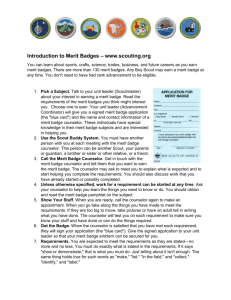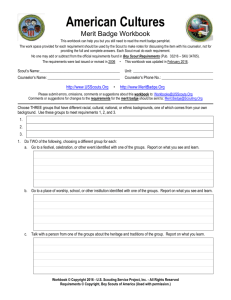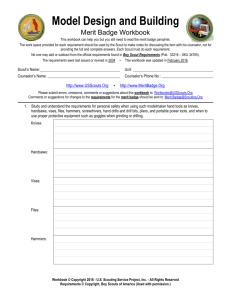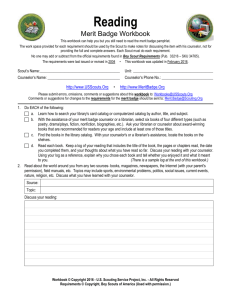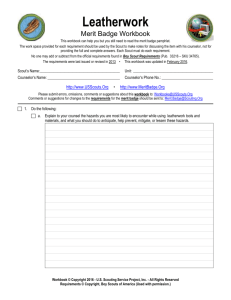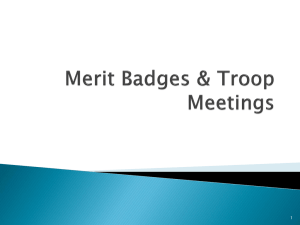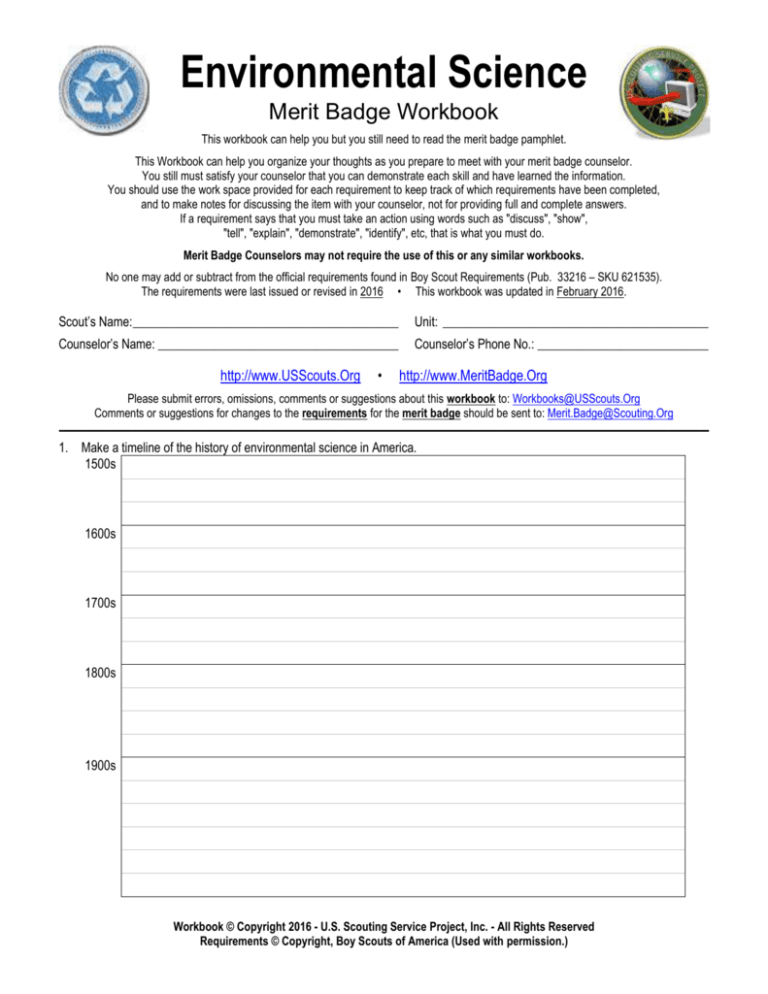
Environmental Science
Merit Badge Workbook
This workbook can help you but you still need to read the merit badge pamphlet.
This Workbook can help you organize your thoughts as you prepare to meet with your merit badge counselor.
You still must satisfy your counselor that you can demonstrate each skill and have learned the information.
You should use the work space provided for each requirement to keep track of which requirements have been completed,
and to make notes for discussing the item with your counselor, not for providing full and complete answers.
If a requirement says that you must take an action using words such as "discuss", "show",
"tell", "explain", "demonstrate", "identify", etc, that is what you must do.
Merit Badge Counselors may not require the use of this or any similar workbooks.
No one may add or subtract from the official requirements found in Boy Scout Requirements (Pub. 33216 – SKU 621535).
The requirements were last issued or revised in 2016 • This workbook was updated in February 2016.
Scout’s Name:__________________________________________
Unit: __________________________________________
Counselor’s Name: ______________________________________
Counselor’s Phone No.: ___________________________
http://www.USScouts.Org
•
http://www.MeritBadge.Org
Please submit errors, omissions, comments or suggestions about this workbook to: Workbooks@USScouts.Org
Comments or suggestions for changes to the requirements for the merit badge should be sent to: Merit.Badge@Scouting.Org
______________________________________________________________________________________________________________________________________________
1. Make a timeline of the history of environmental science in America.
1500s
1600s
1700s
1800s
1900s
Workbook © Copyright 2016 - U.S. Scouting Service Project, Inc. - All Rights Reserved
Requirements © Copyright, Boy Scouts of America (Used with permission.)
Environmental Science
Scout's Name: ________________________
2000s
Identify the contribution made by the Boy Scouts of America to environmental science. Include dates, names of people or
organizations, and important events.
Date
People/Organizations
Event
2. Define the following terms: population, community, ecosystem, biosphere, symbiosis, niche, habitat, conservation, threatened
species, endangered species, extinction, pollution prevention, brownfield, ozone, watershed, airshed, nonpoint source, hybrid
vehicle, fuel cell.
Population:
Community:
Ecosystem:
Biosphere:
Environmental Science - Merit Badge Workbook
Page. 2 of 19
Environmental Science
Scout's Name: ________________________
Symbiosis:
Niche:
Habitat:
Conservation:
Threatened species:
Endangered species:
Extinction
Pollution prevention:
Brownfield:
Ozone:
Watershed:
Environmental Science - Merit Badge Workbook
Page. 3 of 19
Environmental Science
Scout's Name: ________________________
Airshed:
Nonpoint source:
Hybrid vehicle:
Fuel cell:
3. Do ONE activity in EACH of the following categories (using the activities in this pamphlet as the bases for planning and
carrying out your projects):
a. Ecology
1. Conduct and experiment to find out how living things respond to changes in their environments. Discuss your
observations with your counselor.
2. Conduct an experiment illustrating the greenhouse effect. Keep a journal of your data and observations. Discuss
your conclusions with your counselor.
3. Discuss what is an ecosystem. Tell how it is maintained in nature and how it survives.
Environmental Science - Merit Badge Workbook
Page. 4 of 19
Environmental Science
Scout's Name: ________________________
b. Air Pollution
1. Perform an experiment to test for particulates that contribute to air pollution. Discuss your findings with your
counselor.
2. Record the trips taken, mileage, and fuel consumption of a family car for seven days, and calculate how many miles
per gallon the car gets. Determine whether any trips could have been combined ("chained") rather than taken out
and back. Using the idea of trip chaining, determine how many miles and gallons of gas could have been saved in
those seven days.
3. Explain what is acid rain. In your explanation, tell how it affects plants and the environment and the steps society
can take to help reduce its effects.
c. Water Pollution
1. Conduct an experiment to show how living things react to thermal pollution. Discuss your observations with your
counselor.
2. Conduct an experiment to identify the methods that could be used to mediate (reduce) the effects of an oil spill on
waterfowl. Discuss your results with your counselor.
3. Describe the impact of a waterborne pollutant on an aquatic community. Write a 100-word report on how that
pollutant affected aquatic life, what the effect was, and whether the effect is linked to biomagnification.
Environmental Science - Merit Badge Workbook
Page. 5 of 19
Environmental Science
Scout's Name: ________________________
d. Land Pollution
1. Conduct an experiment to illustrate soil erosion by water. Take photographs or make a drawing of the soil before
and after your experiment, and make a poster showing your results. Present your poster to your patrol or troop. (Per
National, “troop” means “unit”.)
2. Perform an experiment to determine the effect of an oil spill on land. Discuss your conclusions with your counselor.
3. Photograph an area affected by erosion. Share your photographs with your counselor and discuss why the area has
eroded and what might be done to help alleviate the erosion.
e. Endangered Species
1. Do research on one endangered species found in your state. Find out what its natural habitat is, why it is
endangered, what is being done to preserve it, and how many individual organisms are left in the wild. Prepare a
100-word report about the organism, including a drawing. Present your report to your patrol or troop.
2. Do research on one species that was endangered, or threatened, but which has now recovered. Find out how the
organism recovered, and what its new status is. Write a 100-word report on the species and discuss it with your
counselor.
3. With your parent's and counselor's approval, work with a natural resource professional to identify two projects that
have been approved to improve the habitat for a threatened or endangered species in your area. Visit the site of one
of these projects and report on what you saw.
Environmental Science - Merit Badge Workbook
Page. 6 of 19
Environmental Science
f.
Scout's Name: ________________________
Pollution Prevention, Resource Recovery, and Conservation
1. Look around your home and determine 10 ways your family can help reduce pollution. Practice at least two of these
methods for seven days and discuss with your counselor what you have learned.
2. Determine 10 ways to conserve resources or use resources more efficiently in your home, at school, or at camp.
Practice at least two of these methods for seven days and discuss with your counselor what you have learned.
3. Perform an experiment on packaging materials to find out which ones are biodegradable. Discuss your conclusions
with your counselor.
g. Pollination
1. Using photographs or illustrations, point out the differences between a drone and a worker bee. Discuss the stages
of bee development (eggs, larvae, pupae). Explain the pollination process, and what propolis is and how it is used
by honey bees. Tell how bees make honey and beeswax, and how both are harvested. Explain the part played in
the life of the hive by the queen, the drones, and the workers.
Environmental Science - Merit Badge Workbook
Page. 7 of 19
Environmental Science
Scout's Name: ________________________
2. Present to your counselor a one-page report on how and why honey bees are used in pollinating food crops. In your
report, discuss the problems faced by the bee population today, and the impact to humanity if there were no
pollinators. Share your report with your troop or patrol, your class at school, or another group approved by your
counselor.
3. Hive a swarm OR divide at least one colony of honey bees. Explain how a hive is constructed
4. Choose two outdoor study areas that are very different from one another (e.g., hilltop vs. bottom of a hill; field vs. forest;
swamp vs. dry land). For BOTH study areas, do ONE of the following:
a. Mark off a plot of 4 square yards in each study area, and count the number of species found there. Estimate how much
space is occupied by each plant species and the type and number of non-plant species you find.
Study Plot Location 1: ________________________________ Number of Species: _____________________________
Plant Species
Space each occupies
Non-Plant Species
Environmental Science - Merit Badge Workbook
Number found
Page. 8 of 19
Environmental Science
Scout's Name: ________________________
Study Plot Location 2: ________________________________ Number of Species: _____________________________
Plant Species
Space each occupies
Non-Plant Species
Environmental Science - Merit Badge Workbook
Number found
Page. 9 of 19
Environmental Science
Scout's Name: ________________________
Write a report that adequately discusses the biodiversity and population density of these study areas. Discuss your report
with your counselor.
Environmental Science - Merit Badge Workbook
Page. 10 of 19
Environmental Science
Scout's Name: ________________________
b. Make at least three visits to each of the two study areas (for a total of six visits), staying for at least 20 minutes each
time, to observe the living and nonliving parts of the ecosystem. Space each visit far enough apart that there are readily
apparent differences in the observations. Keep a journal that includes the differences you observe
Study Area 1:
Visit 1 Date: _________________________ Time Started: ________________ Time Ended _____________________
Observations of living parts:
Observations of nonliving parts:
Differences noted:
Environmental Science - Merit Badge Workbook
Page. 11 of 19
Environmental Science
Scout's Name: ________________________
Visit 2 Date: _________________________ Time Started: ________________ Time Ended _____________________
Observations of living parts:
Observations of nonliving parts:
Differences noted:
Environmental Science - Merit Badge Workbook
Page. 12 of 19
Environmental Science
Scout's Name: ________________________
Visit 3 Date: _________________________ Time Started: ________________ Time Ended _____________________
Observations of living parts:
Observations of nonliving parts:
Differences noted:
Environmental Science - Merit Badge Workbook
Page. 13 of 19
Environmental Science
Scout's Name: ________________________
Study Area 2:
Visit 1 Date: _________________________ Time Started: ________________ Time Ended _____________________
Observations of living parts:
Observations of nonliving parts:
Differences noted:
Environmental Science - Merit Badge Workbook
Page. 14 of 19
Environmental Science
Scout's Name: ________________________
Visit 2 Date: _________________________ Time Started: ________________ Time Ended _____________________
Observations of living parts:
Observations of nonliving parts:
Differences noted:
Environmental Science - Merit Badge Workbook
Page. 15 of 19
Environmental Science
Scout's Name: ________________________
Visit 3 Date: _________________________ Time Started: ________________ Time Ended _____________________
Observations of living parts:
Observations of nonliving parts:
Differences noted:
Environmental Science - Merit Badge Workbook
Page. 16 of 19
Environmental Science
Scout's Name: ________________________
Then, write a short report that adequately addresses your observations, including how the differences of the study areas
might relate to the differences noted, and discuss this with your counselor.
5. Using the construction project provided or a plan you create on your own, identify the items that would need to be included in
an environmental impact statement for the project planned.
Environmental Science - Merit Badge Workbook
Page. 17 of 19
Environmental Science
Scout's Name: ________________________
6. Find out about three career opportunities in environmental science.
1.
2.
3.
Pick one and explain how to prepare for such a career.
Discuss with your counselor what education and training are required, and explain why this profession might interest you.
Education
Training
Why this profession might interest you.
Requirement resources can be found here:
http://www.meritbadge.org/wiki/index.php/Environmental Science#Requirement resources
Environmental Science - Merit Badge Workbook
Page. 18 of 19
Important excerpts from the Guide To Advancement - 2015, No. 33088 (SKU-620573)
[1.0.0.0] — Introduction
The current edition of the Guide to Advancement is the official source for administering advancement in all Boy Scouts of America programs: Cub Scouting, Boy
Scouting, Varsity Scouting, Venturing, and Sea Scouts. It replaces any previous BSA advancement manuals and previous editions of the Guide to Advancement.
[Page 2, and 5.0.1.4] — Policy on Unauthorized Changes to Advancement Program
No council, committee, district, unit, or individual has the authority to add to, or subtract from, advancement requirements. There are limited exceptions
relating only to youth members with special needs. For details see section 10, “Advancement for Members With Special Needs”.
[Page 2] — The “Guide to Safe Scouting” Applies
Policies and procedures outlined in the Guide to Safe Scouting, No. 34416, apply to all BSA activities, including those related to advancement and Eagle Scout
service projects.
[7.0.3.1] — The Buddy System and Certifying Completion
A youth member must not meet one-on-one with an adult. Sessions with counselors must take place where others can view the interaction, or the Scout must have a
buddy: a friend, parent, guardian, brother, sister, or other relative—or better yet, another Scout working on the same badge—along with him attending the session. If
merit badge counseling or instruction includes any Web-based interaction, it must be conducted in accordance with the BSA Social Media Guidelines
(http://www.scouting.org/Marketing/Resources/SocialMedia). For example, always copy one or more authorized adults on email messages between counselors and
Scouts.
When the Scout meets with the counselor, he should bring any required projects. If these cannot be transported, he should present evidence, such as photographs or
adult verification. His unit leader, for example, might state that a satisfactory bridge or tower has been built for the Pioneering merit badge, or that meals were
prepared for Cooking. If there are questions that requirements were met, a counselor may confirm with adults involved. Once satisfied, the counselor signs the blue
card using the date upon which the Scout completed the requirements, or in the case of partials, initials the individual requirements passed.
Note that from time to time, it may be appropriate for a requirement that has been met for one badge to also count for another. See “Fulfilling More Than One
Requirement With a Single Activity,” 4.2.3.6.
[7.0.3.2] — Group Instruction
It is acceptable—and sometimes desirable—for merit badges to be taught in group settings. This often occurs at camp and merit badge midways, fairs, clinics, or
similar events. Interactive group discussions can support learning. The method can also be attractive to “guest experts” assisting registered and approved
counselors. Slide shows, skits, demonstrations, panels, and various other techniques can also be employed, but as any teacher can attest, not everyone will learn all
the material.
There must be attention to each individual’s projects and his fulfillment of all requirements. We must know that every Scout —actually and personally— completed
them. If, for example, a requirement uses words like “show,” “demonstrate,” or “discuss,” then every Scout must do that. It is unacceptable to award badges on the
basis of sitting in classrooms watching demonstrations, or remaining silent during discussions.
It is sometimes reported that Scouts who have received merit badges through group instructional settings have not fulfilled all the requirements. To offer a quality
merit badge program, council and district advancement committees should ensure the following are in place for all group instructional events.
A culture is established for merit badge group instructional events that partial completions are acceptable expected results.
A guide or information sheet is distributed in advance of events that promotes the acceptability of partials, explains how merit badges can be finished after
events, lists merit badge prerequisites, and provides other helpful information that will establish realistic expectations for the number of merit badges that can be
earned at an event.
Merit badge counselors are known to be registered and approved.
Any guest experts or guest speakers, or others assisting who are not registered and approved as merit badge counselors, do not accept the responsibilities of,
or behave as, merit badge counselors, either at a group instructional event or at any other time. Their service is temporary, not ongoing.
Counselors agree to sign off only requirements that Scouts have actually and personally completed.
Counselors agree not to assume prerequisites have been completed without some level of evidence that the work has been done. Pictures and letters from
other merit badge counselors or unit leaders are the best form of prerequisite documentation when the actual work done cannot be brought to the camp or site
of the merit badge event.
There is a mechanism for unit leaders or others to report concerns to a council advancement committee on summer camp merit badge programs, group
instructional events, and any other merit badge counseling issues—especially in instances where it is believed BSA procedures are not followed. See
“Reporting Merit Badge Counseling Concerns,” 11.1.0.0.
There must be attention to each individual’s projects and his fulfillment of all requirements. We must know that every Scout—actually and personally—
completed them.
It is permissible for guest speakers, guest experts, or others who are not merit badge counselors to assist in the counseling process. Those providing such
assistance must be under the direction of a registered and approved counselor who is readily available onsite, and provides personal supervision to assure all
applicable BSA policies and procedures—including those related to BSA Youth Protection—are in place and followed.
[7.0.3.3] — Partial Completions
A Scout need not pass all the requirements of one merit badge with the same counselor. It may be that due to timing or location issues, etc., he must meet with a
different counselor to finish the badge. The Application for Merit Badge has a place to record what has been finished—a “partial.” In the center section on the reverse
of the blue card, the counselor initials for each requirement passed. In the case of a partial completion, the counselor does not retain his or her portion of the card. A
subsequent counselor may choose not to accept partial work, but this should be rare. A Scout, if he believes he is being treated unfairly, may work with his unit leader
to find another counselor. An example for the use of a signed partial would be to take it to camp as proof of prerequisites. Partials have no expiration except the
Scout’s 18th birthday. Units, districts, or councils shall not establish other expiration dates for partial merit badges.
[7.0.4.8] — Unofficial Worksheets and Learning Aids
Worksheets and other materials that may be of assistance in earning merit badges are available from a variety of places including unofficial sources on the Internet
and even troop libraries. Use of these aids is permissible as long as the materials can be correlated with the current requirements that Scouts must fulfill. Completing
“worksheets” may suffice where a requirement calls for something in writing, but this would not work for a requirement where the Scout must discuss, tell, show, or
demonstrate, etc. Note that Scouts shall not be required to use these learning aids in order to complete a merit badge.



